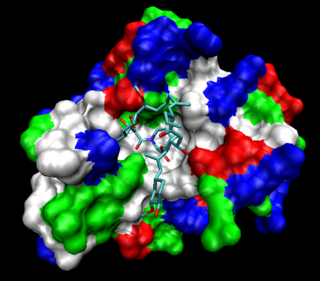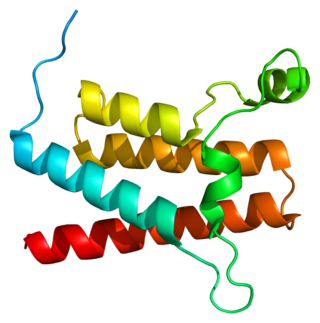Related Research Articles

Calcineurin (CaN) is a calcium and calmodulin dependent serine/threonine protein phosphatase. It activates the T cells of the immune system and can be blocked by drugs. Calcineurin activates nuclear factor of activated T cell cytoplasmic (NFATc), a transcription factor, by dephosphorylating it. The activated NFATc is then translocated into the nucleus, where it upregulates the expression of interleukin 2 (IL-2), which, in turn, stimulates the growth and differentiation of the T cell response. Calcineurin is the target of a class of drugs called calcineurin inhibitors, which include ciclosporin, voclosporin, pimecrolimus and tacrolimus.

In molecular biology, SWI/SNF, is a subfamily of ATP-dependent chromatin remodeling complexes, which is found in eukaryotes. In other words, it is a group of proteins that associate to remodel the way DNA is packaged. This complex is composed of several proteins – products of the SWI and SNF genes, as well as other polypeptides. It possesses a DNA-stimulated ATPase activity that can destabilize histone-DNA interactions in reconstituted nucleosomes in an ATP-dependent manner, though the exact nature of this structural change is unknown. The SWI/SNF subfamily provides crucial nucleosome rearrangement, which is seen as ejection and/or sliding. The movement of nucleosomes provides easier access to the chromatin, enabling binding of specific transcription factors, and allowing genes to be activated or repressed.

Stuart Schreiber is an American chemist who is the Morris Loeb Research Professor at Harvard University, a co-Founder of the Broad Institute, Howard Hughes Medical Institute Investigator, Emeritus, and a member of the National Academy of Sciences and National Academy of Medicine. He currently leads Arena BioWorks.

The FKBPs, or FK506 binding proteins, constitute a family of proteins that have prolyl isomerase activity and are related to the cyclophilins in function, though not in amino acid sequence. FKBPs have been identified in many eukaryotes, ranging from yeast to humans, and function as protein folding chaperones for proteins containing proline residues. Along with cyclophilin, FKBPs belong to the immunophilin family.
Nuclear factor of activated T-cells (NFAT) is a family of transcription factors shown to be important in immune response. One or more members of the NFAT family is expressed in most cells of the immune system. NFAT is also involved in the development of cardiac, skeletal muscle, and nervous systems. NFAT was first discovered as an activator for the transcription of IL-2 in T cells but has since been found to play an important role in regulating many more body systems. NFAT transcription factors are involved in many normal body processes as well as in development of several diseases, such as inflammatory bowel diseases and several types of cancer. NFAT is also being investigated as a drug target for several different disorders.

Transcription activator BRG1 also known as ATP-dependent chromatin remodeler SMARCA4 is a protein that in humans is encoded by the SMARCA4 gene.

Nuclear factor of activated T-cells, cytoplasmic 2 is a protein that in humans is encoded by the NFATC2 gene.

Nuclear factor of activated T-cells, cytoplasmic 1 is a protein that in humans is encoded by the NFATC1 gene.

SWI/SNF-related matrix-associated actin-dependent regulator of chromatin subfamily B member 1 is a protein that in humans is encoded by the SMARCB1 gene.

AT-rich interactive domain-containing protein 1A is a protein that in humans is encoded by the ARID1A gene.

SWI/SNF complex subunit SMARCC1 is a protein that in humans is encoded by the SMARCC1 gene.

Nuclear factor of activated T-cells, cytoplasmic 3 is a protein that in humans is encoded by the NFATC3 gene.

SWI/SNF-related matrix-associated actin-dependent regulator of chromatin subfamily E member 1 is a protein that in humans is encoded by the SMARCE1 gene.

Nuclear factor of activated T-cells, cytoplasmic 4 is a protein that in humans is encoded by the NFATC4 gene.

Calcineurin subunit B type 1 also known as protein phosphatase 2B regulatory subunit 1 is a protein that in humans is encoded by the PPP3R1 gene.

Protein polybromo-1 (PB1) also known as BRG1-associated factor 180 (BAF180) is a protein that in humans is encoded by the PBRM1 gene.

SWI/SNF-related matrix-associated actin-dependent regulator of chromatin subfamily D member 3 is a protein that in humans is encoded by the SMARCD3 gene.

SWI/SNF-related matrix-associated actin-dependent regulator of chromatin subfamily D member 2 is a protein that in humans is encoded by the SMARCD2 gene.

Chemically induced dimerization (CID) is a biological mechanism in which two proteins bind only in the presence of a certain small molecule, enzyme or other dimerizing agent. Genetically engineered CID systems are used in biological research to control protein localization, to manipulate signalling pathways and to induce protein activation.

Diana Hargreaves is an American biologist and assistant professor at The Salk Institute for Biological Studies and member of The Salk Cancer Center. Her laboratory focuses on epigenetic regulation by the BAF (SWI/SNF) chromatin remodeling complexes in diverse physiological processes including development, immunity, and diseases such as cancer.
References
- ↑ Fornace AJ, Cummings DE, Comeau CM, Kant JA, Crabtree GR. Single copy inverted repeats associated with regional duplications in gamma fibrinogen and immunoglobulin genes. Science. 224(4645): 161-164, 1984. PMID 6322310.
- ↑ Courtois G, Morgan JG, Campbell LA, Fourel G, Crabtree, GR. Interaction of a liver-specific nuclear factor with the fibrinogen and alpha1- antitrypsin promoters. Science. 238(4827): 688-692, 1987. PMID 3499668.
- ↑ Kant JA, Crabtree GR. Alternative mRNA splicing patterns produce the gamma A and gamma B chains of fibrinogen. Cell. 31(1): 159-166, 1982. PMID 6896326.
- ↑ Shaw JP, Utz PJ, Durand DB, Toole JJ, Emmel EA, Crabtree GR. Identification of a putative regulator of early T cell activation genes. Science. 241(4862): 202-205, 1988. PMID 3260404.
- ↑ Emmel EA, Verweij CL, Durand DB, Higgins KM, Lacy E, Crabtree GR. Cyclosporin A specifically inhibits function of nuclear proteins involved in T cell activation. Science. 246(4937): 1617-1620, 1989. PMID 2595372.
- ↑ Flanagan WM, Corthésy B, Bram RJ, Crabtree GR. Nuclear association of a T-cell transcription factor blocked by FK-506 and cyclosporin A. Nature. 352(3668): 803-807, 1991. PMID 1715516
- ↑ Clipstone NA, Crabtree GR. Identification of calcineurin as a key signalling enzyme in T-lymphocyte activation. Nature. 357(6380): 695-697, 1992. PMID 1377362.
- ↑ Graef IA, Mermelstein PG, Stankunas K, Neilson JR, Deisseroth K, Tsien RW, Crabtree GR. L-type calcium channels and GSK-3 regulate the activity of NF-ATc4 in hippocampal neurons. Nature. 401(6754): 703-708, 1999. PMID 10537109.
- ↑ Schreiber SL, Crabtree, GR. The mechanism of action of cyclosporin A and FK506. Immunology Today. 4: 136-142, 1992. PMID 1374612.
- ↑ Kolata, G. Scientists decipher mysterious process of signaling in cells. New York Times. June 1993.
- ↑ Crabtree, GR, Olson, EN. NFAT signaling: choreographing the social lives of cells. Cell. 109: S67-79, 2002. PMID 11983154.
- ↑ Arron JR, Winslow MM, Polleri A, Chang CP, Wu H, Gao X, Neilson JR, Chen L, Heit JJ, Kim SK, Yamasaki N, Miyakawa T, Francke U, Graef IA, Crabtree GR. NFAT dysregulation by increased dosage of DSCR1 and DYRK1A on chromosome 21. Nature. 441(7093): 595-600, 2006. PMID 16554754.
- ↑ Kuo CJ, Chung J, Fiorentino DF, Flanagan WM, Blenis J, Crabtree GR. Rapamycin selectively inhibits interleukin-2 activation of p70 S6 kinase. Nature. 358(6381): 70-73, 1992. PMID 1614535.
- ↑ Spencer, David M.; Wandless, Thomas J.; Schreiber, Stuart L.; Crabtree, Gerald R. (1993-11-12). "Controlling Signal Transduction with Synthetic Ligands". Science. 262 (5136): 1019–1024. Bibcode:1993Sci...262.1019S. doi:10.1126/science.7694365. ISSN 0036-8075. PMID 7694365.
- ↑ Spencer, David M.; Wandless, Thomas J.; Schreiber, Stuart L.; Crabtree, Gerald R. (1993-11-12). "Controlling Signal Transduction with Synthetic Ligands". Science. 262 (5136): 1019–1024. Bibcode:1993Sci...262.1019S. doi:10.1126/science.7694365. ISSN 0036-8075. PMID 7694365.
- ↑ Holsinger, L J; Spencer, D M; Austin, D J; Schreiber, S L; Crabtree, G R (1995-10-10). "Signal transduction in T lymphocytes using a conditional allele of Sos". Proceedings of the National Academy of Sciences. 92 (21): 9810–9814. Bibcode:1995PNAS...92.9810H. doi: 10.1073/pnas.92.21.9810 . ISSN 0027-8424. PMC 40892 . PMID 7568223.
- 1 2 Spencer, D M; Graef, I; Austin, D J; Schreiber, S L; Crabtree, G R (1995-10-10). "A general strategy for producing conditional alleles of Src-like tyrosine kinases". Proceedings of the National Academy of Sciences. 92 (21): 9805–9809. Bibcode:1995PNAS...92.9805S. doi: 10.1073/pnas.92.21.9805 . ISSN 0027-8424. PMC 40891 . PMID 7568222.
- 1 2 Klemm, Juli D; Beals, Chan R; Crabtree, Gerald R (September 1997). "Rapid targeting of nuclear proteins to the cytoplasm". Current Biology. 7 (9): 638–644. Bibcode:1997CBio....7..638K. doi: 10.1016/S0960-9822(06)00290-9 . PMID 9285717.
- 1 2 Ho, Steffan N.; Biggar, Stephen R.; Spencer, David M.; Schreiber, Stuart L.; Crabtree, Gerald R. (August 1996). "Dimeric ligands define a role for transcriptional activation domains in reinitiation". Nature. 382 (6594): 822–826. Bibcode:1996Natur.382..822H. doi:10.1038/382822a0. ISSN 0028-0836. PMID 8752278.
- 1 2 Hathaway, Nathaniel A.; Bell, Oliver; Hodges, Courtney; Miller, Erik L.; Neel, Dana S.; Crabtree, Gerald R. (June 2012). "Dynamics and Memory of Heterochromatin in Living Cells". Cell. 149 (7): 1447–1460. doi:10.1016/j.cell.2012.03.052. PMC 3422694 . PMID 22704655.
- ↑ Liang, Fu-Sen; Ho, Wen Qi; Crabtree, Gerald R. (2011-03-15). "Engineering the ABA Plant Stress Pathway for Regulation of Induced Proximity". Science Signaling. 4 (164). doi:10.1126/scisignal.2001449. ISSN 1945-0877. PMC 3110149 . PMID 21406691.
- ↑ Stanton, Benjamin Z.; Chory, Emma J.; Crabtree, Gerald R. (2018-03-09). "Chemically induced proximity in biology and medicine". Science. 359 (6380). doi:10.1126/science.aao5902. ISSN 0036-8075. PMC 6417506 .
- ↑ Ye, Xuehai; Rivera, Victor M.; Zoltick, Philip; Cerasoli, Franklin; Schnell, Michael A.; Gao, Guang-ping; Hughes, Joseph V.; Gilman, Michael; Wilson, James M. (January 1999). "Regulated Delivery of Therapeutic Proteins After in Vivo Somatic Cell Gene Transfer". Science. 283 (5398): 88–91. Bibcode:1999Sci...283...88Y. doi:10.1126/science.283.5398.88. ISSN 0036-8075.
- ↑ Samarasinghe, Kusal T.G.; Crews, Craig M. (July 2021). "Targeted protein degradation: A promise for undruggable proteins". Cell Chemical Biology. 28 (7): 934–951. doi:10.1016/j.chembiol.2021.04.011. PMC 8286327 . PMID 34004187.
- ↑ Gourisankar, Sai; Krokhotin, Andrey; Ji, Wenzhi; Liu, Xiaofan; Chang, Chiung-Ying; Kim, Samuel H.; Li, Zhengnian; Wenderski, Wendy; Simanauskaite, Juste M.; Yang, Haopeng; Vogel, Hannes; Zhang, Tinghu; Green, Michael R.; Gray, Nathanael S.; Crabtree, Gerald R. (2023-08-10). "Rewiring cancer drivers to activate apoptosis". Nature. 620 (7973): 417–425. Bibcode:2023Natur.620..417G. doi:10.1038/s41586-023-06348-2. ISSN 0028-0836. PMC 10749586 . PMID 37495688.
- ↑ Khavari PA, Peterson CL, Tamkun JW, Mendel DB, Crabtree GR. BRG1 contains a conserved domain of the SWI2/SNF2 family necessary for normal mitotic growth and transcription. Nature. 366(6451): 170-174, 1993. PMID 8232556.
- ↑ Wang W, Côté J, Xue Y, Zhou S, Khavari PA, Biggar SR, Muchardt C, Kalpana GV, Goff SP, Yaniv M, Workman JL, Crabtree GR. Purification and biochemical heterogeneity of the mammalian SWI-SNF complex. EMBO J. 15(19): 5370-5382, 1996. PMID 8895581.
- ↑ Wu JI, Lessard J, Crabtree GR. Understanding the words of chromatin regulation. Cell. 136(2): 200-206, 2009. PMID 19167321.
- ↑ Yoo AS, Staahl BT, Chen L, Crabtree GR. MicroRNA-mediated switching of chromatin-remodelling complexes in neural development. Nature. 460(7261): 642-646, 2009. PMID 19561591.
- ↑ Yoo AS, Sun AX, Li L, Shcheglovitov A, Portmann T, Li Y, Lee-Messer C, Dolmetsch RE, Tsien RW, Crabtree GR. MicroRNA-mediated conversion of human fibroblasts to neurons. Nature. 476(7359): 228-231, 2011. PMID 21753754.
- ↑ Kadoch C, Hargreaves DC, Hodges C, Elias L, Ho L, Ranish J, Crabtree GR. Proteomic and bioinformatic analysis of mammalian SWI/SNF complexes identifies extensive roles in human malignancy. Nat Genet. 45(6): 592-601, 2013. PMID 23644491.
- ↑ Kadoch C, Crabtree GR. Reversible disruption of mSWI/SNF (BAF) complexes by the SS18-SSX oncogenic fusion in synovial sarcoma. Cell. 153(1): 71-85, 2013. PMID 23540691.
- ↑ Dykhuizen EC, Hargreaves DC, Miller EL, Cui K, Korshunov A, Kool M, Pfister S, Cho YJ, Zhao K, Crabtree GR. BAF complexes facilitate decatenation of DNA by topoisomerase IIalpha. Nature. 497(7451): 624-627, 2013. PMID 23698369.
- ↑ Roach J. C. et al, Science 80, 636–639. 10.1126; Kong et al Nature volume 488, pages 471–475 (2012); Kondrashov et al Nature volume 488, pages 467–468 (2012); Campbell C. D., Eichler E. E. (2013). Trends Genet. 29, 575–584; Michaelson J. J. et al. Cell 151, 1431– 1442
- ↑ Principals of Neuroscience, Kandel ER, Koester JD Mack SH and Siegelbaum SA MacGraw Hill 2021